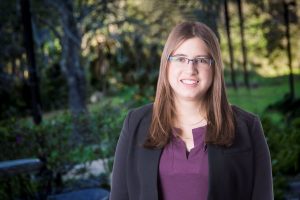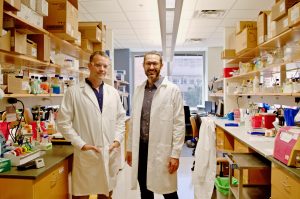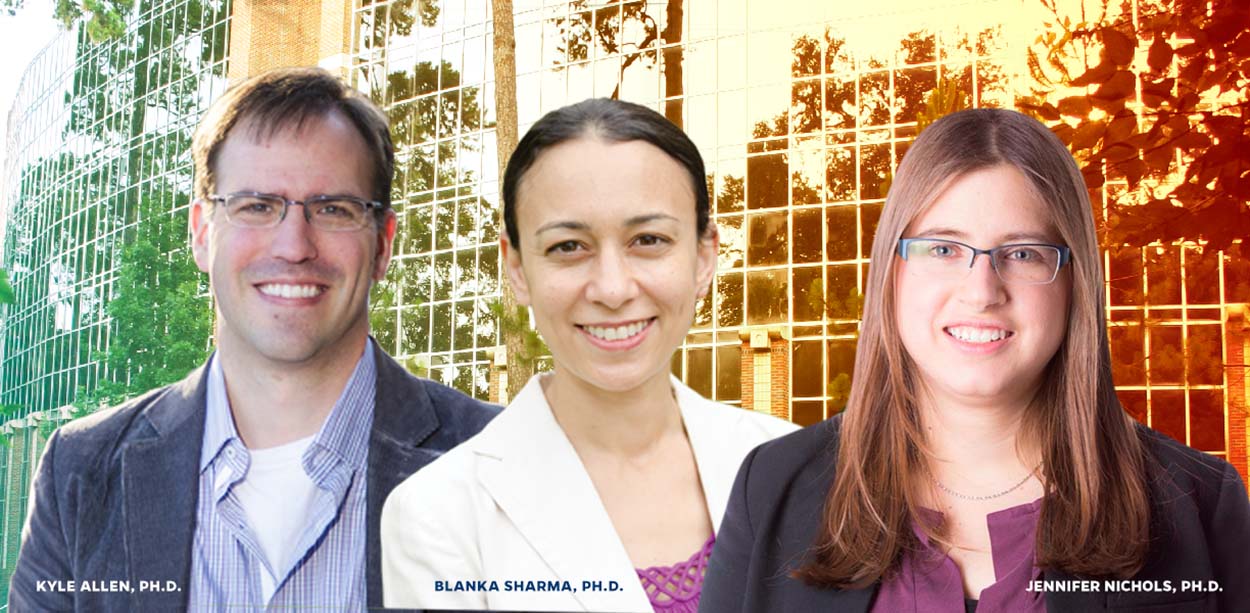Osteoarthritis (OA), the most common form of arthritis, affects more than 30 million Americans. According to the National Institutes of Health (NIH), “OA is caused by a breakdown of cartilage (the tissue that covers the ends of bones where they form a joint). Healthy cartilage allows bones to glide over one another, and it absorbs energy from the shock of physical movement. In osteoarthritis, the surface layer of cartilage breaks down and wears away. This results in bones under the cartilage rubbing together, causing pain, swelling, and stiffness. Bone spurs develop, permanently changing the joint’s shape.” This degenerative disease causes increasingly consequential lowered quality of life.
The University of Florida’s J. Crayton Pruitt Family Department of Biomedical Engineering (BME) receives more funding from the National Institute of Arthritis and Musculoskeletal and Skin Diseases’ (NIAMS) than any other biomedical engineering department nationally, according to the NIH Research Portfolio Online Reporting Tools (RePORT, September 2019). UF is fourth overall and top among public institutions in all sources of funding to BME departments for the study of osteoarthritis, joining the ranks of Stanford, Case Western and Columbia universities. This funding recognition underscores the significance of the research being done at UF. It also underscores the unique ability of UF as a premiere public land-grant institution to bring together co-located multidisciplinary research across its campus in finding not one but many, comprehensive solutions, in this case, for the painful issues of osteoarthritis.
MULTI-MODAL TARGETING WITH ADVANCED CELL THERAPY
Blanka Sharma, Ph.D.
BME assistant professor Blanka Sharma and her collaborators are developing new drug delivery systems to simultaneously target multiple, synergistic disease mechanisms within osteoarthritic joints. Her work aims to transform joint conditions from inflammatory and degenerative to healing and regenerative. The research is providing new insights into OA disease mechanisms through cell-targeting approaches, while advancing new drug delivery technologies with cartilage-protecting and immune-modulating agents.
To reduce the need for frequent injections due to rapid clearance of drugs from the body and to localize drugs to their target tissues, Sharma is endeavoring to deliver drugs attached to micro- and nano-size particles made from biocompatible polymers. Kartogenin-coated nano-particles will be “painted” directly onto cartilage with a sealant, while CD200-coated micro-particles large enough to limit their clearance will be injected directly into the joint cavity. These two methods are being studied in preclinical OA models, both separately and in combination, to reveal whether simultaneous delivery can impact OA more than either of the treatments alone.
This new delivery approach could advance the field of targeted delivery in the joint by opening the door for previously ineffective drugs to reach their target tissues. “[In addition,] findings could give insight regarding how immune cell behavior and cartilage protection affect OA progression, which could help researchers inch closer to a cure for OA,” Sharma said.
TREATING NON-CARTILAGE PAIN TO ENHANCE EXERCISE
Kyle Allen, Ph.D.
More recently, NIH-funded clinical trials have shown that exercise reduces joint pain and stiffness, and increases flexibility, muscle strength, cardiac fitness, and endurance. Although effective, exercise can be difficult for some patients due to pre-existing OA-related pain. BME associate professor Kyle D. Allen is measuring how joint tissues other than cartilage react to exercise. His study focuses on non-cartilage factors such as bone structure, inflammation and neural sensitivity that could potentially exacerbate OA symptoms.
“Exercise is one of the most clinically effective forms of OA management, but exactly how exercise elicits improvement in the first place is not yet completely understood,” Allen said. He and his team are studying exercise in pre-clinical models to analyze tissue changes during improvement of OA symptoms. Findings from this study could bring about new drug targets to help alleviate symptoms and make it easier for patients to reap the benefits of exercise.
“If there are things that we can do to protect the joint from pain during the act of exercising, which might make exercising a little bit more feasible for the person to incorporate into their lifestyle, then [potentially] this is a better way of managing osteoarthritic pain and disability,” Allen said.
PREDICTIVE BIOMECHANICAL SIMULATIONS PAVE THE WAY FOR MORE EFFECTIVE REHAB AND THERAPY

Jennifer Nichols, Ph.D.
Assistant Professor Jennifer Nichols’ research broadly focuses on musculoskeletal biomechanics. Her long-term goal is to create predictive, biomechanical simulations to improve the functional ability and quality of life for individuals with musculoskeletal disorders, including osteoarthritis. Nichols creates computer models that replicate how the musculoskeletal system responds to pathologies and treatments. With a grant from the University of Florida Clinical and Translational Science Institute (CTSI), Dr. Nichols has been modeling profiles of patients with and without thumb osteoarthritis, to help inform the development of surgery and physical therapy for patients with this ailment. Her predictive simulations will catalyze clinical advancements using modern, data-driven medicine that will ultimately become more personalized, precise and effective.
ANCHORING LOCALIZED ENZYMES TO BLOCK OA INFLAMMATION

Greg Hudalla, Ph.D. & Benjamin Keselowsky, Ph.D.
BME professor Benjamin Keselowsky’s research focuses on drug delivery strategies to treat inflammation and autoimmune disease, and assistant professor Greg Hudalla concentrates on anchoring enzymes in place where they can remain long enough to effectively carry out chemical reactions. Together Keselowsky and Hudalla were able to localize enzyme activity for a sufficient period of time to meet their requirements.
“Our next step is to select the enzyme(s) we want to use for specific activities such as blocking inflammation due to periodontitis or osteoarthritis and to initiate projects to help reduce inflammation in human and animal subjects,” said Keselowsky.
TREATING OA WHILE MANAGING PAIN
The biomedical engineering program at UF has made a purposeful impact through its interaction with the Pain Reduction Intervention Center of Excellence (PRICE) at the UF College of Medicine, whose researchers are looking at the measurement of pain in relation to osteoarthritis and the treatment of pain and inflammation to mitigate the disease. Their work has shown that osteoarthritis exacerbates a number of other disease states. “UF has created an area of strength around the focus on osteoarthritis treatment at this institution that is very pain centric. We have a pain-first philosophy in OA therapies,” said Allen. “Opioids and non-steroidal anti-inflammatory drugs (NSAIDS) are not a good or a long-term solution for OA pain management, so we are looking for better treatments.”
“UF has a very unique approach – experts from across specialties collaborate to bring a broader and deeper knowledge to understanding the early detection and treatment of osteoarthritis, finding new therapies at every stage of the disease,” said Christine Schmidt, Professor, J. Crayton Pruitt Family Chair & Department Chair of Biomedical Engineering.
FACTS ABOUT OSTEOARTHRITIS TREATMENT
In the first half of the 20th century, osteoarthritis sufferers avoided exercise and took aspirin for pain. In the mid-1970s, nonsteroidal anti-inflammatory drugs such as ibuprofen came on the market to provide slightly stronger, longer-lasting relief than aspirin for OA.
Knee and hip replacements have become more prevalent in older patients (over 65) to reduce the deterioration and pain. Surgical advances and development of longer-lasting materials, as well as designs that more closely mimic natural joints have made joint replacement surgery a better alternative in advanced stages of OA.
The NIH Fact Sheet says, “In 1982, approximately 75,000 total hip replacements were being performed annually in the United States.” By 2000, that number had grown to 254,000 annually. In 2006, approximately 542,000 knee replacement surgeries were also performed. According to the National Inpatient Sample, in 2014 there were 370,770 total hip replacements and 680,150 total knee replacements. Matthew Sloan, MD, orthopaedic resident at the University of Pennsylvania was the lead author of a study presented to the American Academy of Orthopaedic Surgeons in March 2018 that showed the projected annual volume of replacement surgeries by 2030. Total hip replacements were projected to increase to 630,000 procedures, and total knee replacements were projected to be 1.28 million procedures.
Today, expanded knowledge about osteoarthritis has pointed to exercise as an effective treatment for osteoarthritis pain.
- Genetics plays a role in protecting against or increasing a person’s risk of developing osteoarthritis.
- Studies have shown that smoking increases joint pain and cartilage degeneration in osteoarthritis sufferers.
- NIH-funded clinical trials have shown that exercise reduces joint pain and stiffness, and increases flexibility, muscle strength, cardiac fitness, and endurance.
- The Framingham study showed that “overweight people who walked or jogged regularly were no more or less likely to have osteoarthritic joint damage than their sedentary overweight peers.”
Engineering a means to reduce chronic pain from osteoarthritis can help patients overcome the worst effects of their OA and focus on fighting other health conditions.
